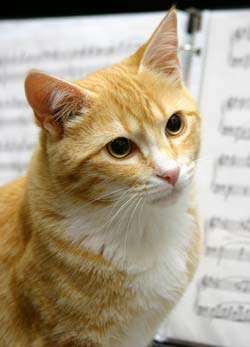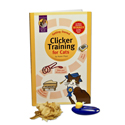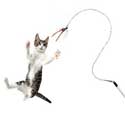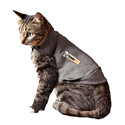Note: Originally published 11/01/2010.
It's easy to teach a cat to play the piano; I've often done it in other people's houses, with their cat, as a sort of after-dinner amusement.
First you lure the cat onto the piano bench with food, clicking as it jumps up. (Present the treats on a plate on the bench, so you don't get grease or tuna juice on your hostess's furniture.) Then you lure or target the cat forward until it puts a paw on the keys. Click. Repeat the process, fading the lure, until the cat is voluntarily stepping on the keys and looking at you for a click. Then begin reinforcing firmer touches until you get good noise-making hits (this is easier with an electronic keyboard than with a regular piano, but either will do).

Professor Jesús Rosales-Ruiz, who teaches in the Department of Behavior Analysis at the University of North Texas, requires all his students, both graduate and undergraduate, to clicker train a pet or some other animal. One of his students trained her cat not only to "play" the piano, but to strike one specific note. Then she put the behavior on a verbal cue. Ultimately she accomplished her rather ambitious goal. She sat at the piano and played part of a Mozart piece in G, while the cat sat next to her, waiting like an orchestra musician for its cue to come in. At the end she gave the cue "Play G," and the cat brought the piece to a close with a resounding plonk on the final signature note. Click! The student's A-grade term project consisted of a video showing the shaping process (including the things that did not work)—as well as the final successful performance.
Here's a further refinement on piano playing. Teach the cat to play the keys two or three times for a click. (This builds up endurance, so the cat won't quit just because it didn't get clicked for any one plonk; thus you have room to select and click only the right sort of plonks.) Put a removable sticker on middle C, as a target, and click the behavior of playing that key only. (You might want to teach "aim for the sticker" separately, by clicking the cat for pawing stickers in other places before adding the task of recognizing the sticker to the piano-playing task.)
When the cat is hitting the marked key reliably, put another sticker just to the right, on D. Your aim is to establish the behavior of hitting D and then C for a click. You'll always be ending up on the note the cat first learned, C, so the cat can proceed with confidence. When D-C is accomplished, add the next note to the right, E, then shape the behavior of playing all three notes, right to left, one time each. Repeat. Presto! Your cat plays the first two bars of "Three Blind Mice."
Excerpted from Getting Started Clicker Training for Cats, by Karen Pryor.








Post new comment